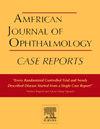Descemet膜内皮角膜移植术联合白内障手术后角膜次全脱离后自发性角膜清除1例报告
Q3 Medicine
引用次数: 0
摘要
目的:fuchs ' s内皮性角膜营养不良(FECD)是一种双侧、散发性或常染色体显性的非炎症性角膜营养不良,其特征是角膜内皮细胞的进行性丧失。虽然DMEK已被证明可以获得更好的术后最佳矫正视力(BCVA),但它也提出了更频繁的术后移植物脱落的挑战。据报道,联合白内障手术和DMEK也会增加术后早期移植物脱离的风险。虽然有几个病例报告表明,在明显的移植物脱离后,角膜会自发清除,但关于需要多少供体组织来实现和维持角膜清除并确保长期最佳视力结果的问题仍然存在。方法在本病例报告中,我们描述了一例FECD患者术后早期在近次全移植物脱离后自发性角膜清除的事件,该患者接受了DMEK联合7.5 mm供体移植物和人工晶状体植入。结果术后第2周,患者出现数指视力,弥漫性微囊性水肿,DMEK移植体脱落75%。术后6个月,患者视力为20/30,角膜清晰,DMEK移植物1 / 4附着并在前房折叠。结论:本病例强调在DMEK联合白内障手术后超过四分之三的供体角膜脱离后自发角膜清除。虽然我们不能预测该患者的长期角膜透明度,但6个月时的稳定性表明,在DMEK移植物附着最小的患者中存在内皮细胞迁移。本文章由计算机程序翻译,如有差异,请以英文原文为准。
Case report of spontaneous corneal clearance after subtotal graft detachment following combined Descemet's membrane endothelial keratoplasty and cataract surgery
Purpose
Fuchs’ Endothelial Corneal Dystrophy (FECD) is a bilateral, sporadic or autosomal dominant, non-inflammatory corneal dystrophy characterized by the progressive loss of corneal endothelial cells. While DMEK has been proven to attain better post-operative best corrected visual acuity (BCVA), it has presented the challenge of more frequent postoperative graft detachments.1,2 Combined cataract surgery along with DMEK has also been reported to increase the risk of early postoperative graft detachment.3While several case reports have illustrated spontaneous corneal clearance after significant graft detachment, the question regarding how much donor tissue is required to achieve and maintain corneal clearance and to ensure long term optimal visual outcomes remains.
Methods
In this case report, we describe an event of spontaneous corneal clearance after near subtotal graft detachment noted in the early postoperative period in a patient with FECD who underwent combined DMEK with a 7.5 mm donor graft and intraocular lens placement.
Results
On postoperative week 2, the patient presented with count fingers vision, diffuse microcystic edema, and 75 % detachment of the DMEK graft. At postoperative month 6, the patient presented with vision of 20/30, a clear cornea, DMEK graft one fourth attached and folded over on itself in the anterior chamber.
Conclusion
Our case highlights spontaneous corneal clearance after more than three-quarters detachment of the donor graft following combined DMEK and cataract surgery. Although we cannot predict long term corneal transparency in our patient, the stability at 6 months implies that there is endothelial cell migration in patients with minimal DMEK graft attachment.
求助全文
通过发布文献求助,成功后即可免费获取论文全文。
去求助
来源期刊

American Journal of Ophthalmology Case Reports
Medicine-Ophthalmology
CiteScore
2.40
自引率
0.00%
发文量
513
审稿时长
16 weeks
期刊介绍:
The American Journal of Ophthalmology Case Reports is a peer-reviewed, scientific publication that welcomes the submission of original, previously unpublished case report manuscripts directed to ophthalmologists and visual science specialists. The cases shall be challenging and stimulating but shall also be presented in an educational format to engage the readers as if they are working alongside with the caring clinician scientists to manage the patients. Submissions shall be clear, concise, and well-documented reports. Brief reports and case series submissions on specific themes are also very welcome.
 求助内容:
求助内容: 应助结果提醒方式:
应助结果提醒方式:


